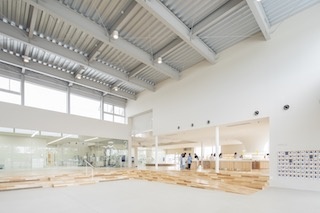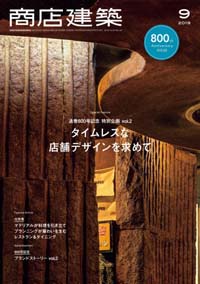SHOTENKENCHIKU /January
2023/12/28 2024

January 2024, SUMMARY
SHOTENKENCHIKU is monthly magazine of Japanese interior design / store design / commercial architecture
NEW SHOP & ENVIRONMENT
K Arena YOKOHAMA
(Page 46)

K-Arena Yokohama is a complex of hotel, office and music arena
developed in the Minato Mirai 21 district of Yokohama. It is a
large-scale development with a site area of approximately 3305㎡,
and the entire site is covered with artificial ground. The deck is a
pedestrian-only space where visitors can stay, and the car flow
and back flow lines are concentrated on the ground floor level
below the deck. Besides, stores are located on the deck and a
large tent is provided for outdoor events. The arena is an endstage
fan shape, the prototype of which can be seen in the ancient
Roman “Amphitheater,” with three-tiered stand seating facing the
stage, aiming to create the best entertainment space where the
20,000 audience members and artists can become one. K-Arena
Yokohama, a 20,000-seat music arena, is the core of the facility
and is expected to have an impact on the entire area.
Designer : Ken Corporation + AZUSA SEKKEI + ILYA
NEW SHOP & ENVIRONMENT
ANNIVERSAIRE OMOTESANDO
(Page 70)

Celebrating its 25th anniversary, “ANNIVERSAIRE OMOTESANDO”
has reopened with the aim of becoming a place that offers luxury
and comfort not only for weddings, but also for other milestones in
life, as well as for various everyday occasions. Nomura Kogeisha
renovated the first, fourth, seventh, and eighth floors, as well as
the chapel. Each area was designed based on the keywords
“connection” in order to expand the options for users, spaces
were created to contrast with the existing floors and make a
variety of scenes.
Designer : NOMURA + A.N.D. NOMURA
SPECIAL FEATURE
Redesigning the "Production Site"
MINNANO - SUNAGAWA FACTORY BY SHIRO
(Page 92)

Cosmetic brand SHIRO opened a factory in Sunagawa, Hokkaido,
where the company was founded.
The factory occupies approximately two-thirds of the site area,
and the rest is occupied by a café, store, kids' space, library, and
other facilities. The factory and other functional areas are
separated by a large glass wall, and the relationship is not one of
seeing and being seen, but one in which the people inside are
simply living with each other. The openness of the product
manufacturing process gives visitors a sense of security and story
about the product, and employees are motivated by seeing
customers take the product in their hands. This project presents a
new model for the relationship between production and
consumption.
Designer : Arii Irie Architects + ODS
SPECIAL FEATURE
Redesigning the "Production Site"
Goto Tsubaki Distillery
(Page 104)

Goto Tsubaki Distillery is a craft gin distillery located in a small
village on Fukue Island in the Goto Islands. This was once an area
where the Christian hiding place lived, and the “Handomari
Church,” a place of prayer, still remains. This distillery, which
brews with local botanicals, was planned as a place rooted in the
local climate. Large distillation machines and tanks are required to
fulfill the functions of a distillery. However, the road leading to this
site is narrow and steep, making it difficult to bring in the lumber
needed to create a large space. Therefore, by assembling the
arch like a beam between small-diameter timbers, a large space
was realized while using local materials. The space is reminiscent
of a church courtyard.
Designer : WANKARASHIN
SPECIAL FEATURE
Redesigning the "Production Site"
CAN-PANY
(Page 111)

CAN-PANY is a canned beverage filling plant planned in Kiyosumi-
Shirakawa, Tokyo.
The company manufactures original drinks using medicinal herbs
from its own herb garden and accepts orders for even small lots.
Since its main function is a factory, it has plenty of space for
functional needs, and its manufacturing is open to the people of
the city. By composing the space with polycarbonate panels and
other building materials commonly used in factories, the factory
itself becomes a showcase. This is a plan for a place in the city
that will serve as a catalyst for uncovering unknown creativity.
Designer: Hideyuki Nakayama Architecture + NOMOTO SEKKEI
FEATURE ARTICLE
RESTAURANT
BLUE NOTE PLACE Ebisu
(Page 154)

Blue Note Place Ebisu is a newly completed jazz bar and
restaurant in Yebisu Garden Place in Ebisu, Tokyo. A large void is
created on the second floor of the building to create a vaulted
space. The second floor, of which only the peripheral portion
remains, has seating for guests to enjoy their meals while looking
downstairs. In addition, by placing the stage near the windows,
the artists' live performances are visible to the city through the
glass windows, so the walls were designed not to be completely
soundproofed so that the sound would ooze out into the city. A
new jazz bar and restaurant has emerged as a new symbol of the
Ebisu area.
Designer: A.N.D. NOMURA
FEATURE ARTICLE
RESTAURANT
Saikyo-yaki Kyoto Yamaroku
(Page 189)

This is the flagship store of Kyoto Yamaroku, which sells Saikyo
pickled fish in department stores and supermarkets nationwide.
Inspired by the “barrel miso” miso floor of the Kyoto Yamaroku
tradition, the concept of the restaurant was set as “a room with a
miso barrel”. A large “miso barrel,” the symbol of the restaurant,
hangs from the ceiling, and nine set meal-style counter seats are
provided. The private room, which can accommodate 4 to 6
people, based on the motif of a miso barrel lying on its side, has a
low ceiling to create a cozy and relaxing space.
Designer: Masterd
FEATURE ARTICLE
RESTAURANT
JAPAN FOOD HALL
(Page 195)

JAPAN FOOD HALL, a restaurant floor, with a design theme of
“Japanese Modern”, has opened in the area after immigration at
Narita International Airport Terminal Two. The facility is composed
of a warm wooden louvered ceiling, lighting fixtures reminiscent of
tea caddies, and cobblestone-style flooring. There are 10 famous
restaurants, mainly Japanese restaurants, where people can enjoy
exclusive and shared seating where they can watch the live
cooking process of the artisans. Tatami room seating is also
available, and Japan's first terrace seating was also created.
Through the large windows, visitors can enjoy the panoramic view
of airplanes taking off and landing.
Designer : RIC DESIGN
SUBSCRIBE
Digital Issue : zinio.com
Print Issue : For overseas subscription and order, please contact to the following
BACK NUMBER
このエントリーのURL
URL










